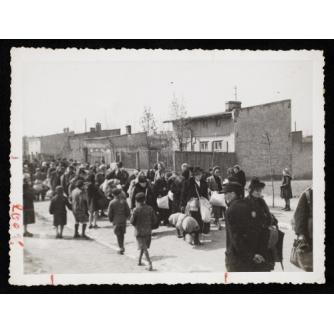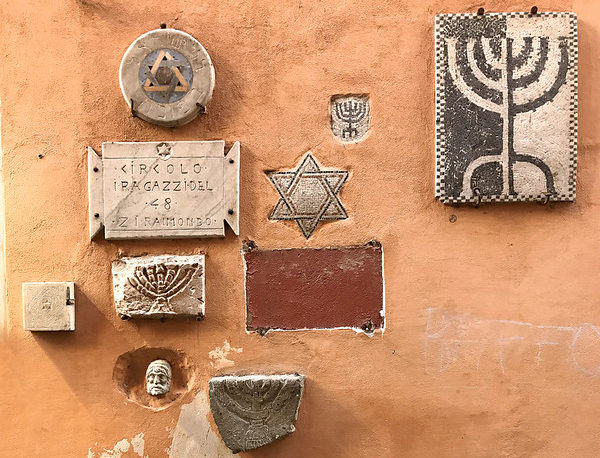There was an estimate of 3.5 million Jews who lived in Poland before the start of World War II. Jews made up 10% of the overall population and Jews made up 30% of the urban population. Of the 3.5 million Jews in Poland, only 10-11% or 380,000 of the pre-war population survived the war.

German troops occupied the city of Lodz in September 1939. In February 1940, the ghetto was established; months later in April 1940, it was sealed off with barbed wire. Approximately 200,000 Jews lived in a cramped 1.6 square mile area throughout the ghetto’s occupation. Of those living within the ghetto, an estimated 164,000 were native Polish Jews and an additional 20,000 were of Western European origin.

Almost a quarter of the ghetto’s population was never deported but died in the ghetto from disease, suffering, and starvation. By 1944, more than 45,000 ghetto residents died of hunger and disease. Less than 1,000 Jews survived the war and were liberated by the Red Army, in January 1945.
Henryk Ross and his photographs
Henryk Ross was used by the Nazi party to take pictures in and around the ghetto that would later be used for propaganda material. These photos were used to show that life inside the ghetto was orderly and productive, allowing for a false narrative of Jewish life within ghettos throughout Nazi-occupied Europe. He later began taking pictures of the horrors that afflicted the occupants of the ghetto.
The following photos are from Henryk Ross’s collection of photos taken in the ghetto. Ross’ images are one of the most complete albums taken during the Holocaust by a Jewish photographer.
All images and captions are from the Art Gallery of Ontario.

I chose Lodz to add to the commonly held misconception of the Holocaust as “striped pajamas” and tattooed prisoner numbers. Lodz is also crucial as it helps in understanding the collective and spatial differences between the Ghetto of Rome and the Lodz ghettos. The spatial and collective memory of the two ghettos vastly vary. This difference is shown through the narrative of today’s Lodz ghetto memorial. The memorial is not symbolic of the same transformative identity that can be seen and felt in Rome. However, the Lodz ghetto and memorial are a testament that without memorialization memory can be entirely lost. The experiences of both ghettos connect Jews living in these different circumstances through a collective understand of diasporic experience. Despite the differences between the two ghettos, the images above depict similar living conditions living and injustices felt by both groups.
Survivor Testimonials
Holocaust testimonials were recorded by Yad Vashem World Holocaust Remembrance Center. The videos below are a part of a larger testimonial project conducted and archived by Yad Vashem, which can be found here.
“Yad Vashem is the ultimate source for Holocaust education, documentati bon, commemoration and research. Its use of innovative technological platforms maximizes accessibility to the vast information in the Yad Vashem archival collections for an expanding global audience. Yad Vashem is at the forefront of unceasing efforts to safeguard and impart the memory of the victims and the events of the Shoah period; to document accurately one of the darkest chapters in the history of humanity, and to grapple effectively with the ongoing challenges of keeping the memory of the Holocaust relevant today and for future generations. “
– Yad Vashem About Us page
The short clips below are Holocaust testimonials from survivors of the Lodz ghetto. The survivors touch upon several topics such as life in the ghetto and life before the war.
The survivor testimonials speak to the power of collective memory. Their individual stories make up the experiences of the Holocaust. Holocaust memory relies on the experience of the individual to fill in for the experiences of those who were lost during the war. The story of Lodz is an attempt at a counter-narrative to the widely known Holocaust stories.
Works Cited
Löw, Andrea. “Documenting as a ‘Passion and Obsession’: Photographs from the Lodz (Litzmannstadt) Ghetto.” Central European History, vol. 48, no. 3, 2015, pp. 387–404. JSTOR, www.jstor.org/stable/43965177
Slideshow citation – “Explore the Collection | The Lodz Ghetto Photographs of Henryk Ross | AGO.” The Lodz Ghetto Photographs of Henryk Ross A Collection Of Holocaust Photographs, lodzghetto.ago.ca/objects/viewcollections?t:state:flow=a6dca123-b8ba-4d9e-9c73-e9ae8d1a9277. Accessed 26 Jan. 2020.


